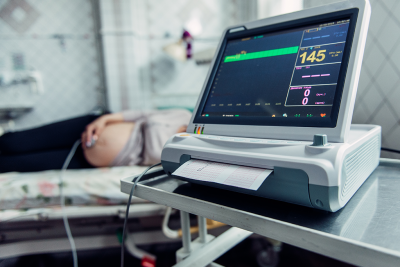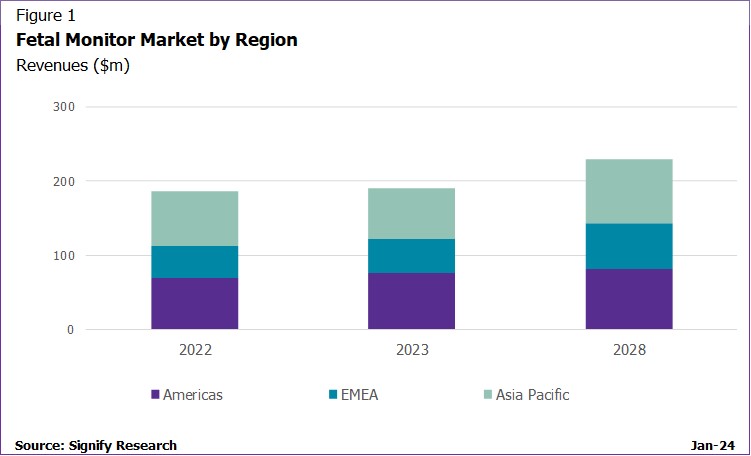
Written by

Cranfield, UK, 2nd February 2024 – The global fetal monitoring market reached $190 million in 2023 and is forecast to rise to $230 million in 2028. The market growth reflects emerging countries expanding their fetal monitoring capability as well as the increasing necessity for fetal monitoring across more developed regions. Signify Research’s recently published report ‘Fetal Monitors – World – 2024’ dives into the product and regional trends currently impacting the market. This article provides a brief snapshot of some of these major trends. A more detailed analysis can be found in the full report.

Americas:
The Americas was the largest market for fetal monitors in 2022 and 2023; however, it is projected to be surpassed by Asia Pacific over the forecast period. The United States market dominates most of the region. The pressure of litigation plays a crucial role in influencing this market as it drives the need for the connectivity of monitors to allow seamless data transmission. The global shortage of healthcare professionals is particularly prominent in the US, reducing the capacity of fetal monitoring. As such, there is increasing demand for product innovations such as interpretation software and cableless monitoring, that improve clinical workflows.
The market across Latin America differs significantly from the more mature northern region. Despite this, a similar trend in a lack of skilled healthcare professionals is present. The main differences are in product preference; price is a significant barrier, driving preference for low-cost monitors with basic functionality. The pandemic highlighted the fragility of many healthcare systems within the region. As a result, many governments have committed to increasing healthcare spending to improve their healthcare infrastructure. The Latin American fetal monitor market is projected to see significant growth as the increase in spending comes to fruition. Other government policies, such as that in Brazil, drive the domestic production of fetal monitors as subsidies and import taxes on imported goods benefit local vendors.
Europe, the Middle East and Africa:
The growth within the EMEA region is driven by the expanding markets within Eastern Europe, the Middle East and Africa (EEMEA). Within Western Europe, there is a rise in high-risk births as maternal age increases and preterm birth rates rise, raising the demand for monitoring. Despite this, over-stretched healthcare resources are leading to the prioritisation of the most essential equipment. Consequently, there has been a reduction in the number of labour and delivery units in many Western European countries, as they aim to consolidate costs. Whilst this reduces the number of units, the capacity for fetal monitoring has increased as unit sizes have increased. Despite a drive for cost-efficiency, product preference remains for the highest functionality of fetal monitors across Western Europe, as features such as maternal monitoring are a standard request.
Eastern Europe is experiencing an increasing presence of lower-cost, high-functionality monitors from Asian vendors. This has the potential to shift the competitive landscape as the acceptance of these monitors increases. Current world events are increasing the instability of the Eastern European market; Signify Research has projected fetal monitor capacity to increase over the forecast as stability returns.
The African market has the largest potential growth in the long term. The market is currently in the early stages of development. There is a gradually increasing awareness and education around the benefits of fetal monitoring. The region’s largest barriers are the existing healthcare infrastructure and the cost of monitors. Government initiatives as well as aid projects look to progress the fetal monitoring market to improve clinical outcomes and remove these barriers.
Asia Pacific:
Within Asia there is not only a large divide between Mature Asia and Emerging Asia but also within these regions. The variation across Mature Asia is characterised by differences in product preference and parameter preference. Functionality continues to be a key focus in fetal monitoring across the region, leading to a growing need for wireless technology in the region. This trend is especially notable in Australia, where there is an increased demand for ambulation during childbirth.
Emerging Asia is driving the growth of the region, allowing Asia Pacific to overtake the Americas in terms of market revenue potential by 2025. faster growth is projected across ASEAN, China and India. Although the population growth rate is slowing in India and China, the sheer number of births each year is increasing in demand, mainly where the initial capacity was inadequate.
In Emerging Asia, prioritising value-based procurement is a prevailing trend. Additionally, there is a preference for devices produced locally, facilitated by regulatory and licensing approval processes that support domestic manufacturing and provide financial incentives.
The Global Outlook:
The fetal monitor market is anticipated to experience consistent growth over the next five years. Despite the current economic challenges placing strain on healthcare institutions and elongating replacement cycles due to restricted budgets, the rising prevalence of IVF and an increasing rate of high-risk births are contributing to heightened demand in mature markets. The importance of flexibility in maternal care drives the need for ambulation, leading to an increased demand for wireless solutions. There is a growing interest in the connectivity of monitors, to manage staff shortages and integrate with Electronic Health Records (EHRs) and digital solutions. Government initiatives are boosting healthcare spending, creating awareness around maternal and infant care, and facilitating market expansion to meet the demands of fetal monitoring. While price remains the primary deciding factor in certain regions, the influx of funding from governments and the growth in aid projects and private partnerships may shift the focus towards high-functionality monitors. Vendors capable of offering advanced functionality at lower costs are poised to thrive and seize the opportunities presented by expanding markets.
Related Research
Fetal Monitor – World – 2024
Signify Research has recently published its “Fetal Monitor – World – 2024” report. This brand-new report provides a deep-dive analysis of the fetal monitor market. It covers the global trends impacting the market and coverage of the competitive landscape. The analysis is broken down to a product and regional level, including fetal monitor insight at a country level.
About The Author
Sam joined Signify Research in 2023 as a Market Analyst within the Clinical Care team. He brings experience working as an Economist for the Intellectual Property Office, creating strategy reviews and impact evaluations, used to aid government trade negotiations. Sam holds a first-class bachelor’s degree in economics from Loughborough University, where modules included topical issues such as healthcare. Away from the office Sam enjoys staying active with dog walks, football and cricket, and his interest in volunteering took him on a charity visit to Ethiopia.
About the Clinical Care Team
The clinical care team provides market intelligence and detailed insights on the clinical care equipment and IT markets. Our areas of coverage include patient monitoring, diagnostic cardiology, infusion pumps, ventilators, anaesthesia devices, and high-acuity IT. Our reports provide a data-centric and global outlook of each market with granular country-level insights. Our research process blends primary data collected from in-depth interviews with healthcare professionals and technology vendors, to provide a balanced and objective view of the market.
About Signify Research
Signify Research provides healthtech market intelligence powered by data that you can trust. We blend insights collected from in-depth interviews with technology vendors and healthcare professionals with sales data reported to us by leading vendors to provide a complete and balanced view of the market trends. Our coverage areas are Medical Imaging, Clinical Care, Digital Health, Diagnostic and Lifesciences and Healthcare IT.
Clients worldwide rely on direct access to our expert Analysts for their opinions on the latest market trends and developments. Our market analysis reports and subscriptions provide data-driven insights which business leaders use to guide strategic decisions. We also offer custom research services for clients who need information that can’t be obtained from our off-the-shelf research products or who require market intelligence tailored to their specific needs.
More Information
To find out more:
E: enquiries@signifyresearch.net
T: +44 (0) 1234 986111
www.signifyresearch.net